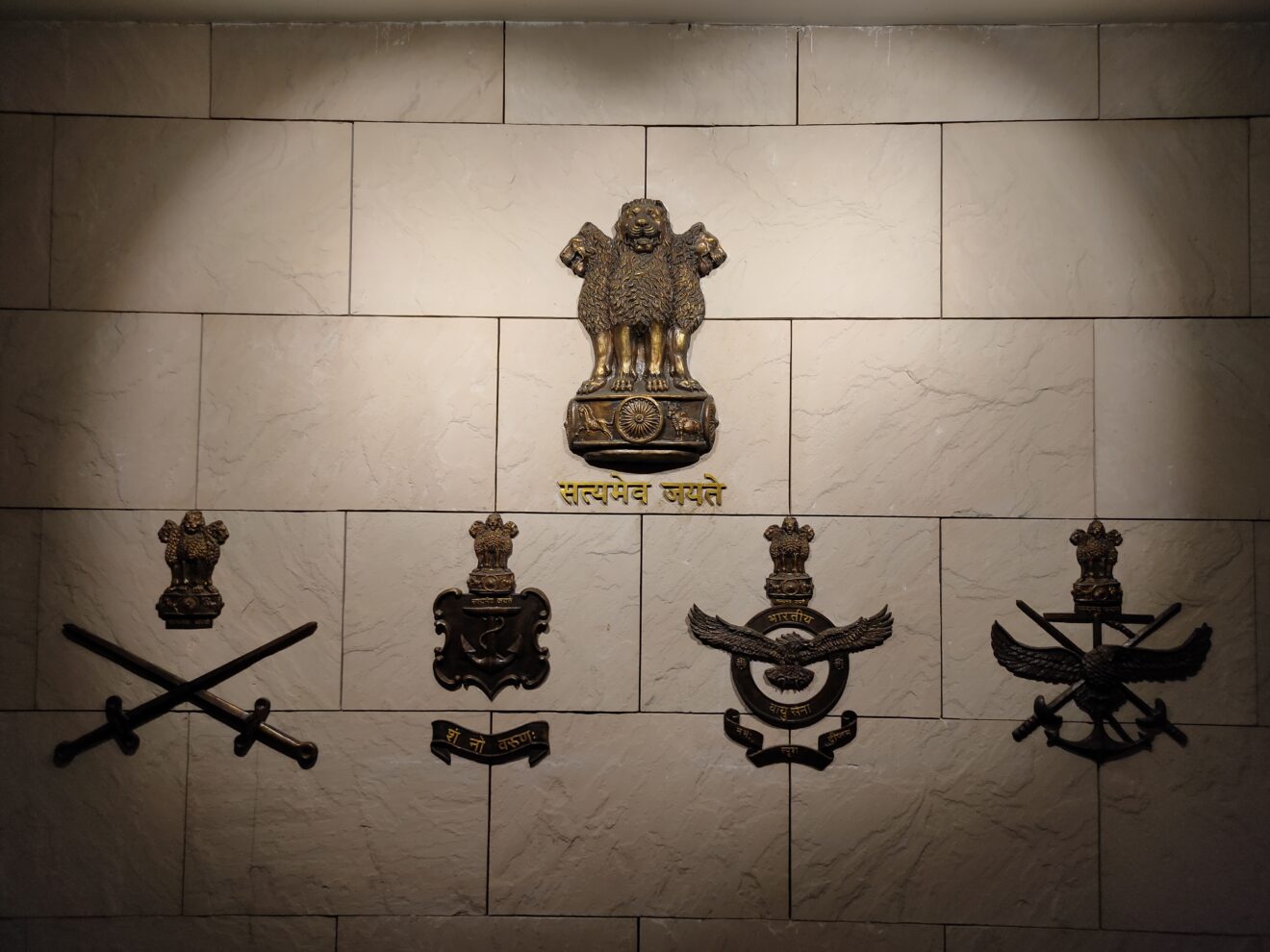In the blazing sands of Jaisalmer, India’s Army and Air Force unleashed unmatched joint might under Operation Trishul. With AI-driven warfare, indigenous drones, and precision strikes, Lt Gen Seth’s words echoed like thunder: “India doesn’t just defend — it dominates.” A loud signal to Pakistan — deterrence is no longer defensive, it’s decisive.
📰
BY DEFENCE JOURNALIST SAHIL | T.I.N. NETWORK
Operation Trishul: Indian Army and Air Force Showcase Joint Firepower in ‘Maru Jwala’ Desert Exercise Near Pakistan Border
Jaisalmer, Rajasthan | 11 November 2025 —
In the blazing sands of Rajasthan’s western frontier, not far from the Pakistan border, the Indian Army and Air Force unleashed a stunning demonstration of integrated warfighting capability under Operation Trishul. The grand finale of this 12-day tri-service exercise — codenamed ‘Maru Jwala’ — brought alive the spirit of India’s modern military doctrine: Jointness, Atmanirbharta, and Innovation (JAI).
Led by Southern Command under the supervision of Lieutenant General Dhiraj Seth, PVSM, AVSM, General Officer Commanding-in-Chief, the exercise marked a new chapter in India’s desert warfare evolution, blending artificial intelligence, robotics, aerial coordination, and real-time information dominance with traditional firepower and manoeuvre tactics.
A Simulated Desert War — Precision, Coordination, and Combat Realism
As dawn broke over the Thar Desert, the quiet stillness of Jaisalmer’s barren expanse was shattered by the thunderous roar of jet engines and the deep rumble of armoured columns. Fighter aircraft streaked low over the horizon, while Apache attack helicopters hovered menacingly above the battlefield, supporting the advancing T-90 Bhishma tanks and mechanised infantry formations of the Sudarshan Chakra Strike Corps.
The exercise simulated coordinated joint strikes on enemy command posts and terrorist hideouts, with drones serving as the eyes of the battlefield. These unmanned systems identified hostile positions and broadcasted evacuation warnings to nearby villages — part of a humanitarian outreach embedded within combat simulation.
Once the “enemy” coordinates were confirmed, ground artillery batteries, mechanised columns, and air support elements launched simultaneous, high-precision strikes. The synergy between ground and air elements — from artillery to fighter jets — underscored India’s capability to execute real-time, multi-domain warfare across a complex, fluid environment.
AI-Driven Warfare: The Rise of Automation and Indigenous Innovation
For the first time in an operational desert exercise, AI-enabled logistics and autonomous combat systems were deployed. Robotic mule dogs carried ammunition and medical aid to injured soldiers under fire. Drones conducted live surveillance and dropped small ammunition packages, while counter-drone systems neutralised simulated aerial threats.
This fusion of technology and tactics is a reflection of the Indian Army’s transformation vision — where battlefield agility is enhanced by innovation. According to Defence PRO Lt Col Nikhil Dhawan, the exercise also validated the field trials of newly inducted indigenous platforms under the “Atmanirbhar Bharat” initiative.
Lt Col Dhawan said, “The Army Commander personally observed the combined arms manoeuvres and battlefield innovations, including home-grown drone and counter-drone systems, that signify how the Army is integrating technology at every level of warfare.”
The presence of indigenous defence technologies on such a scale marked a major leap towards self-reliance in combat systems, particularly in electronic warfare, communications, and battlefield automation.
Lt Gen Dhiraj Seth: Maru Jwala Symbolises India’s JAI Doctrine
During his field inspection, Lt Gen Dhiraj Seth, who heads the Southern Command, emphasised that ‘Maru Jwala’ embodies the Indian Army’s JAI Mantra — Jointness, Atmanirbharta (Self-Reliance), and Innovation.
“The Maru Jwala exercise, as part of the tri-service Operation Trishul, is a crucial milestone. This phase represents the culmination of two months of intense training by the Sudarshan Chakra Strike Corps, including its primary formation — the Shahbaz Rapid Division — along with the Aviation Brigade, Electronic Warfare Brigade, and Para Special Forces units of Southern Command,” said Lt Gen Seth.
He praised the coordination between the Konark Corps and Battle Axe Division, noting that both formations have demonstrated “exemplary synergy, adaptability, and technical excellence.”
Lt Gen Seth reiterated that the exercise reaffirms India’s commitment to integrated operations, ensuring that the Army and Air Force operate not as separate entities, but as one cohesive fighting machine.
The Southern Command’s Strategic Mandate
The Southern Command, headquartered in Pune, is responsible for securing India’s vast western front — stretching across Rajasthan, Gujarat, and Maharashtra. Under Lt Gen Seth’s leadership, the command has emerged as the epicentre of joint and integrated warfighting experimentation within the Indian Armed Forces.
Operation Trishul and Exercise Maru Jwala are part of a broader effort to validate multi-domain operational synergy — combining land, air, cyber, and information warfare into a unified strategic capability.
Lt Gen Seth’s earlier inspection of Exercise Akhand Prahar, a key component of Trishul, also highlighted the Army’s operational preparedness and joint interoperability with the Indian Air Force (IAF). The exercise served as a live testbed for indigenous defence technologies, electronic warfare modules, and battlefield communications systems.
Tactical Excellence Meets Strategic Vision
‘Maru Jwala’ wasn’t merely a show of firepower; it was a demonstration of how India’s war doctrine has evolved to meet the demands of modern hybrid warfare. The integration of drones, precision-guided munitions, and real-time intelligence sharing created a digitally enabled battlefield — a glimpse into the Indian Army of 2030.
Senior officers present at the exercise noted that the simulations resembled real-world operational scenarios, especially those relevant to counter-terror operations and cross-border contingencies.
The Shahbaz Rapid Division’s fast-manoeuvre warfare, in sync with IAF’s precision strikes, demonstrated how India can conduct deep penetration missions across desert sectors with minimal reaction time.
A New Era of Jointness: From Training to Transformation
The overarching goal of Operation Trishul is to establish a permanent framework of interoperability between the three services — Army, Air Force, and Navy — ensuring seamless coordination across all domains.
Military analysts believe that the Maru Jwala phase showcased the Army’s rapid adaptation to digitised command networks, AI-based decision support systems, and tactical data integration. These capabilities, once fully operationalised, could redefine India’s ability to fight short, swift, high-intensity wars along its western front.
The exercise also strengthened civil-military coordination in the region, involving joint communication drills with district administration and local law enforcement agencies.
From the Sands of Jaisalmer to India’s Strategic Doctrine
‘Maru Jwala’ holds immense significance beyond its tactical value. It reflects India’s larger strategic vision for multi-domain deterrence — where the Army’s ground strength, Air Force’s precision, and indigenous technological advancements converge into one powerful doctrine of deterrence.
Defence experts point out that the exercise sends a clear message: India’s western defences are impregnable, and its armed forces are mission-ready for any eventuality.
The final phase concluded with a combined live-fire assault, featuring artillery barrages, coordinated aerial bombing runs, and rapid mechanised thrusts across simulated enemy lines — a sight reminiscent of real-time warfare.
Operation Trishul: India’s Message of Preparedness and Power
As smoke cleared over the desert horizon, the message from the Indian Armed Forces was unmistakable — India’s preparedness is not reactive, it is proactive, precise, and purpose-driven.
The tri-service coordination under Operation Trishul and the battlefield brilliance displayed in Exercise Maru Jwala underscore India’s transition into a next-generation military power, one that is technologically superior, strategically agile, and fully self-reliant.
In the words of Lt Gen Dhiraj Seth:
“The Indian Army is not only protecting the borders — it is shaping the nation’s future through innovation, technology, and excellence in joint operations.”
From the sands of Jaisalmer to the corridors of South Block, Maru Jwala will be remembered as the defining moment of India’s modern military transformation — where synergy forged strength, and strategy met steel under the blazing desert sun.
“मरु ज्वाला” की आग में तपा पाकिस्तान — ले. जनरल धीरज सेठ बोले, ‘भारत अब जवाब नहीं, वार करेगा… और वो भी रेगिस्तान से आसमान तक!’
जैसलमेर की रेत पर गरजा भारत का “ऑपरेशन त्रिशूल” — थल और वायु सेना ने मिलकर दिखाई ऐसी संयुक्त शक्ति कि पाकिस्तान तक गूंजा संदेश: भारत अब हर मोर्चे पर तैयार है, आत्मनिर्भर भी है और आक्रामक भी।
BY DEFENCE JOURNALIST SAHIL | T.I.N. NETWORK
ऑपरेशन त्रिशूल: भारत की थल और वायु सेनाओं का संयुक्त ‘मरु ज्वाला’ युद्धाभ्यास — जैसलमेर की रेत पर दिखी अग्नि, आकाश और आत्मनिर्भरता की ताकत
जैसलमेर, राजस्थान | 11 नवम्बर 2025 —
भारत की पश्चिमी सीमा से सटे जैसलमेर के तपते रेगिस्तान में सोमवार को भारतीय थल सेना और वायु सेना ने संयुक्त रूप से वह करिश्मा दिखाया जिसे देखकर पूरा मरुस्थल गूंज उठा। यह केवल एक युद्धाभ्यास नहीं था, बल्कि भारत की आधुनिक सैन्य शक्ति, ‘संयुक्तता, आत्मनिर्भरता और नवाचार (JAI)’ की जीवंत मिसाल थी।
‘ऑपरेशन त्रिशूल’ के तहत आयोजित इस विशाल स्तर के अभ्यास का अंतिम चरण — ‘मरु ज्वाला’ — भारतीय सेना के इतिहास में अब तक का सबसे उन्नत तकनीकी और सामरिक प्रदर्शन साबित हुआ। इस अभ्यास का नेतृत्व सदर्न कमांड के जनरल ऑफिसर कमांडिंग-इन-चीफ लेफ्टिनेंट जनरल धीरज सेठ (PVSM, AVSM) के निर्देशन में हुआ। उन्होंने इस पूरे युद्धाभ्यास की प्रत्यक्ष रूप से समीक्षा की और इसे भारत की नई युद्धनीति का प्रतिबिंब बताया।
रेगिस्तान में जंग का सजीव दृश्य — गोलों की गरज, हेलिकॉप्टरों की दहाड़ और रणनिति की सटीकता
सुबह की पहली किरणों के साथ ही जैसलमेर के रेतीले मैदानों में एक साथ टैंकों की गर्जना और लड़ाकू विमानों की गर्जना गूंज उठी। भारतीय वायु सेना के फाइटर जेट्स आसमान में दुश्मन की लोकेशन पर तेज़ प्रहार करते नज़र आए, जबकि AAC के Apache अटैक हेलिकॉप्टरों ने अपने मिसाइल सिस्टम के साथ हवा से ज़मीन पर सटीक वार किए।
जमीन पर T-90 भीष्म टैंक, BMP इन्फेंट्री फाइटिंग व्हीकल्स, और सुदर्शन चक्र स्ट्राइक कॉर्प्स की मशीनी टुकड़ियों ने आगे बढ़ते हुए दुश्मन के ठिकानों को तबाह करने का वास्तविक अभ्यास किया।
इस युद्धाभ्यास का परिदृश्य एक संयुक्त हवाई-थल हमले (Combined Arms Manoeuvre) पर आधारित था। पहले ड्रोन से दुश्मन की स्थिति का पता लगाया गया, फिर वायु सेना के विमानों ने उन ठिकानों को निशाना बनाया। उसके बाद तोपखाने और मशीनी बलों ने समन्वित रूप से आक्रमण शुरू किया।
इन सभी गतिविधियों में भारतीय सेना की नई तकनीकी क्षमता और सामरिक एकता साफ नज़र आई।
कृत्रिम बुद्धिमत्ता और स्वदेशी तकनीक का संगम: मरुस्थल में दिखा भविष्य का युद्धक्षेत्र
इस अभ्यास में पहली बार कृत्रिम बुद्धिमत्ता (AI) और स्वचालित प्रणालियों (Automation) का बड़ा इस्तेमाल किया गया।
रोबोटिक म्यूल डॉग्स (Robot Mule Dogs) ने अग्रिम मोर्चे पर घायल सैनिकों तक दवाइयां और गोला-बारूद पहुँचाया।
ड्रोन सिस्टम्स ने न केवल दुश्मन की मूवमेंट ट्रैक की बल्कि छोटे-छोटे अम्युनिशन पैकेज गिराकर सप्लाई चेन बनाए रखी।
साथ ही, सेना के काउंटर-ड्रोन सिस्टम्स ने आसमान में मौजूद दुश्मन के सिम्युलेटेड UAVs को नष्ट किया — यह दिखाने के लिए कि भारतीय सेना अब हवाई खतरों का मुकाबला अपने ही विकसित सिस्टम से करने में सक्षम है।
डिफेंस पीआरओ लेफ्टिनेंट कर्नल निखिल धवन ने बताया कि,
“इस अभ्यास में कई नई स्वदेशी तकनीकें, जैसे होम-ग्रो ड्रोन, काउंटर-ड्रोन सिस्टम, इलेक्ट्रॉनिक वारफेयर उपकरण और ऑटोमेशन आधारित प्लेटफॉर्म, का सफल परीक्षण किया गया है।”
उन्होंने बताया कि यह अभ्यास आत्मनिर्भर भारत के रक्षा सिद्धांत की दिशा में एक बड़ा कदम है, जिसमें भारतीय सेना हर स्तर पर तकनीकी नवाचार को अपनाने में अग्रणी भूमिका निभा रही है।
ले. जनरल धीरज सेठ ने कहा — ‘मरु ज्वाला’ सेना के ‘JAI मंत्र’ की सजीव अभिव्यक्ति है
फील्ड विजिट के दौरान ले. जनरल सेठ ने कहा कि मरु ज्वाला केवल एक अभ्यास नहीं बल्कि भारतीय सेना के तीन स्तंभों — संयुक्तता (Jointness), आत्मनिर्भरता (Atmanirbharta) और नवाचार (Innovation) — की साक्षात झलक है।
“मरु ज्वाला अभ्यास त्रि-सेवा ऑपरेशन त्रिशूल का अहम हिस्सा है। यह चरण सुदर्शन चक्र स्ट्राइक कॉर्प्स की दो महीने की कठिन ट्रेनिंग का परिणाम है। इसमें शाहबाज़ रैपिड डिविज़न, सदर्न कमांड की एविएशन ब्रिगेड, इलेक्ट्रॉनिक वारफेयर ब्रिगेड और पारा एसएफ यूनिट्स शामिल रहे,” उन्होंने कहा।
उन्होंने कहा कि कोणार्क कॉर्प्स और बैटल एक्स डिविजन के बीच शानदार सामंजस्य, लचीलापन और तकनीकी उत्कृष्टता इस अभ्यास का सबसे बड़ा परिणाम है।
सदर्न कमांड का सामरिक नेतृत्व — मरु ज्वाला बना ‘संयुक्त युद्धनीति’ का परीक्षण मैदान
पुणे स्थित सदर्न कमांड भारतीय सेना का सबसे विस्तृत परिचालन क्षेत्र नियंत्रित करती है, जिसमें राजस्थान, गुजरात और महाराष्ट्र का विशाल भूभाग शामिल है।
ले. जनरल सेठ के नेतृत्व में यह कमांड अब भारतीय सशस्त्र सेनाओं के संयुक्त युद्ध सिद्धांत (Joint Warfighting Doctrine) के केंद्र के रूप में उभरी है।
ऑपरेशन त्रिशूल और अभ्यास मरु ज्वाला का उद्देश्य था — बहु-क्षेत्रीय (Multi-Domain) युद्ध क्षमता का परीक्षण, जिसमें भूमि, वायु, इलेक्ट्रॉनिक और साइबर स्पेस सभी को एकीकृत किया गया।
इससे पहले उन्होंने अभ्यास अखंड प्रहार की भी समीक्षा की थी, जिसमें सेना और वायु सेना के बीच इंटरऑपरेबिलिटी और परिचालन तत्परता का गहन मूल्यांकन किया गया था।
डिजिटल युद्ध का नया युग — स्मार्ट सेनाएं, सटीक रणनीति
‘मरु ज्वाला’ केवल फायरपावर का प्रदर्शन नहीं था — यह भविष्य के युद्ध का पूर्वाभास था।
इस युद्धाभ्यास ने दिखाया कि कैसे भारतीय सेना डिजिटल नेटवर्किंग, रीयल-टाइम डेटा शेयरिंग, और AI-आधारित निर्णय प्रणाली के साथ भविष्य के ‘हाइब्रिड वॉरफेयर’ के लिए तैयार है।
शाहबाज़ रैपिड डिविजन की गतिशीलता और IAF के प्रिसिजन स्ट्राइक का संयोजन दिखाता है कि भारत अब गहराई तक सटीक और तेज़ कार्रवाई करने की क्षमता रखता है, चाहे परिस्थितियां कैसी भी हों।
ऑपरेशन त्रिशूल: भारत की संयुक्त शक्ति का सन्देश
इस अभ्यास ने यह स्पष्ट संदेश दिया —
भारत की सैन्य शक्ति अब केवल रक्षा तक सीमित नहीं, बल्कि प्रो-एक्टिव, तकनीकी रूप से सक्षम और रणनीतिक रूप से निर्णायक है।
त्रि-सेवा सहयोग के इस मॉडल ने यह भी दिखाया कि भारत अब वैश्विक युद्धनीति के स्तर पर ‘इंटीग्रेटेड फोर्स’ के रूप में उभर चुका है।
मरु ज्वाला का हर चरण — चाहे वह तोपखाने की गूंज हो या आकाश में गरजते हेलिकॉप्टर — यह याद दिलाता है कि भारत के लिए सीमा सुरक्षा केवल कर्तव्य नहीं, बल्कि अस्तित्व का प्रतीक है।
मरुस्थल की रेत से उभरा भारत का नया सैन्य स्वरूप
जब अभ्यास के अंत में हवा में धुआं छंटा, तो वह दृश्य केवल एक अभ्यास का नहीं था —
वह एक घोषणा थी:
भारत की सीमाएं सुरक्षित हैं, सेना सजग है, और हर चुनौती के लिए तैयार है।
लेफ्टिनेंट जनरल धीरज सेठ के शब्दों में:
“भारतीय सेना केवल सीमाओं की रक्षा नहीं कर रही — वह तकनीकी नवाचार और संयुक्त उत्कृष्टता के माध्यम से भारत का भविष्य गढ़ रही है।”
‘मरु ज्वाला’ भारतीय सेना के इतिहास में एक मील का पत्थर साबित होगा —
जहां रणनीति ने इस्पात से हाथ मिलाया,
जहां तकनीक ने परंपरा को नई दिशा दी,
और जहां रेगिस्तान की रेत से भारत की आधुनिक सैन्य क्रांति जन्मी।












Add Comment